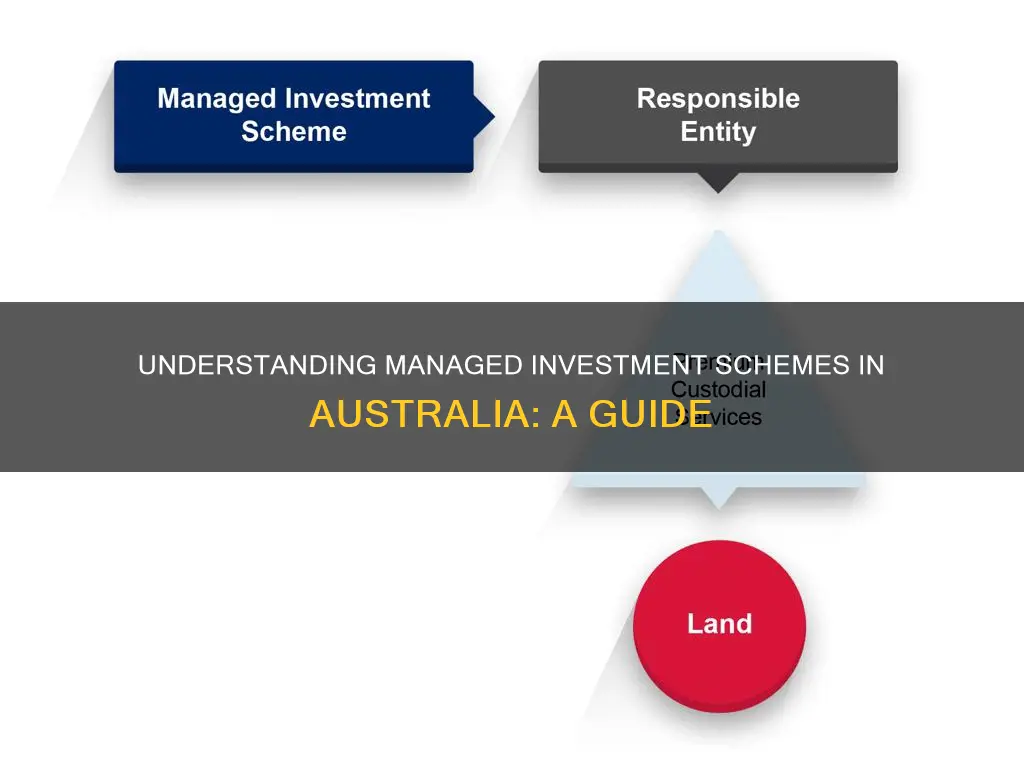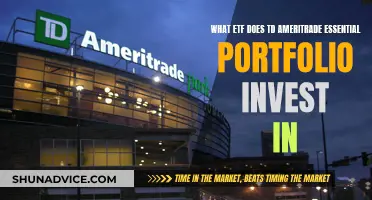
A managed investment scheme (MIS) is a type of investment vehicle that enables a group of investors to pool their money for the purpose of generating financial returns. Managed investment schemes are governed by the Corporations Act 2001 and are regulated by the Australian Securities and Investments Commission (ASIC). These schemes are typically structured as unit trusts, where investors hold units in the trust and rely on a managing party to invest the pooled funds for profit. The concept of managed investment schemes was introduced in Australia in July 1998, providing investors with access to a diverse range of assets and asset classes. While managed investment schemes can be either registered or unregistered, all schemes must be operated by a manager with an Australian Financial Services (AFS) Licence.
What You'll Learn

What is a managed investment scheme?
A managed investment scheme (MIS) is a scheme that enables a group of investors to contribute money that is pooled for investment to produce a financial benefit.
Section 9 of the Corporations Act 2001 (Cth) contains the definition of a managed investment scheme, which must have three particular features:
- Investors contribute money or money’s worth as consideration to acquire rights (interests) to benefits that are produced by the scheme.
- All contributions from investors are pooled or used for a common purpose to further produce benefits. Benefits may be financial or consist of rights or interests in property.
- The members of the scheme (investors) are not active in controlling the scheme’s day-to-day operations.
The concept of managed investment schemes was introduced in July 1998 by the Managed Investments Act (Cth), which replaced the old "prescribed interests" regime. Its most significant change was the replacement of the roles of trustee and manager with a single role. It also introduced new measures to ensure adequate investor protection.
Managed investment schemes are a popular investment arrangement as they provide investors with access to assets and asset classes that may otherwise be inaccessible. These trust-based investment schemes, which can also be referred to as managed funds and collective investments, are typically structured as unit trusts. Investors hold units in the trust and rely on a managing party to appropriately invest the pooled funds for a profit, which members are then entitled to on a pro-rata basis.
A managed investment scheme can be either registered or unregistered. Regardless, all managed investment schemes must be operated by a manager with an Australian Financial Services Licence (AFS Licence) authorising it to run the scheme. A scheme must be registered with the Australian Securities and Investments Commission (ASIC) if it has 20 or more members, is promoted by a person who is in the business of promoting managed investment schemes, or ASIC has otherwise determined that the scheme must be registered.
How Management's Investment Impacts Team Success
You may want to see also

How to register a managed investment scheme
A managed investment scheme is a scheme that enables a group of investors to contribute money that is pooled for investment to produce a financial benefit. To register a managed investment scheme, the following steps must be taken:
When to Register a Scheme
A managed investment scheme must be registered if it has more than 20 members or is promoted by a person in the business of promoting managed investment schemes. Some schemes may be exempt from registration, for example, if all interests in the scheme are issued to wholesale clients only. Unregistered schemes are referred to as "unregistered schemes" and their operators must generally hold an AFS licence to issue, vary, and dispose of interests in the scheme to wholesale investors.
Applying to Register a Scheme
To apply, the responsible entity will need to submit an application, selecting the kind of scheme being registered. The scheme must be one of the following:
- Financial asset schemes
- Direct real property schemes
- Stable property trusts or syndicates
- Listed property trusts
- Service strata schemes
- Primary production schemes
- Time-sharing schemes
If the scheme does not fit within these categories, a tailored AFS licence authorisation may be needed to operate the scheme.
Lodging Your Application
The application must include:
- A copy of the scheme's constitution
- A copy of the scheme's compliance plan
- Form 5103 Directors' statement relating to the application, signed by the directors of the proposed responsible entity, confirming that the scheme's constitution and compliance plan comply with the relevant sections of the Corporations Act
- Annexure that cross-references the contents of the constitution required by the relevant sections of the Corporations Act to the equivalent provisions in the scheme's constitution
- If necessary, agents' authorities appointing another person to sign the compliance plan
Additional Requirements for the Responsible Entity
The proposed responsible entity must:
- Be a registered Australian public company
- Hold an Australian financial services (AFS) licence authorising the responsible entity to operate the scheme and provide any other relevant financial services in relation to the scheme and its underlying assets
Additional Requirements for Registered Schemes
Where a scheme is required to be registered, the following must be addressed:
- A Responsible Entity must be appointed (versus a trustee for an unregistered managed investment scheme)
- The Responsible Entity must be an Australian public company holding an AFS Licence authorising it to act as a Responsible Entity
- The Responsible Entity must have minimum net tangible assets of $50,000 or 0.5% of the value of the scheme’s gross assets, up to $5 million assuming a custodian is appointed, otherwise $10 million is required
- Custodians must be appointed in some cases
- A Constitution, similar to a trust deed, that meets the Corporations Act requirements must be executed and lodged with ASIC
- A Compliance Plan must be created and lodged with ASIC, setting out the measures which a Responsible Entity is to undertake in operating the scheme to ensure compliance with the constitution and the Corporations Act
- A Compliance Committee is to be created if the board of directors of the Responsible Entity does not consist of at least half external directors
Savings-to-Investment Ratio: A Window to Your Financial Health
You may want to see also

Types of managed funds
Managed funds in Australia come in all shapes and sizes, catering to a range of risk appetites and financial goals. Here is a list of some of the types of managed funds available to investors:
Actively Managed Funds
The focus of actively managed funds is on outperforming a specific benchmark, such as the S&P/ASX 200. Fund managers use a range of strategies, methods, and analyses to make investment decisions. They closely monitor market trends, economic data, company fundamentals, and other factors to identify buying and selling opportunities. However, the higher potential returns offered by actively managed funds often come with higher management fees.
Passively Managed Funds
Passively managed funds, often referred to as index funds, differ from actively managed funds in that they aim to replicate a specific market index rather than beat it. An index is a snapshot of a particular financial market segment, such as the S&P/ASX 200. Because the fund does not attempt to pick winners over losers, the management requirements are less intensive, resulting in lower fees.
Unlisted Managed Funds
Unlisted managed funds are not listed or traded on a public securities exchange, such as the ASX. Instead, they are typically available for investment directly from the fund manager.
Single Asset Managed Funds
These managed funds invest in a single asset class, such as shares, property, or bonds. Examples include:
- Cash management trusts
- Fixed interest or bond funds
- Mortgage schemes
- Property funds
- Share (equity) funds
Mixed Asset or Multi-Sector Managed Funds
These funds invest in a range of assets, typically with a focus on shares and property, and the remainder in cash or fixed interest.
Balanced Funds
Balanced funds aim for a mix of asset types, such as shares, bonds, and property, to spread risk and achieve stable returns.
Specialised Funds
Specialised funds focus on specific sectors or investment strategies. They might focus on industries like technology or healthcare, regions like emerging markets, or sectors such as commercial property or ethical investments that align with certain values.
Investment Managers: New Products, Alpha Generation?
You may want to see also

What isn't a managed investment scheme?
A managed investment scheme is a collective investment vehicle, where multiple investors contribute money to a pooled fund, which is then managed by a fund manager. The fund manager is responsible for the day-to-day operations of the scheme and invests the pooled funds for a profit.
However, not all investment schemes are managed investment schemes. Typically, only investments that are 'collective' are considered managed investment schemes. Here are some examples of investments that are not managed investment schemes:
- Regulated Superannuation Funds: These are superannuation products that are regulated by the government or a financial authority. They are not considered managed investment schemes as they are not collective investments and do not typically involve pooling of funds from multiple investors.
- Approved Deposit Funds: Similar to superannuation funds, these are also not considered managed investment schemes as they are regulated and do not involve the pooling of funds.
- Debentures Issued by a Body Corporate: Debentures are a form of debt instrument issued by a company, and they do not fall under the definition of a managed investment scheme.
- Direct Purchases of Shares or Other Equities: When individuals directly purchase shares or equities, it is not a managed investment scheme as there is no pooling of funds and each investor independently owns and controls their investments.
- Schemes Operated by Australian Banks: Investments schemes operated by Australian banks in the ordinary course of their banking business, such as term deposits, are not considered managed investment schemes. These are typically individual investments made with a bank, rather than a collective investment scheme.
Strategies for Allocating Your Investment Portfolio Wisely
You may want to see also

When to register a managed investment scheme
A managed investment scheme in Australia must be registered if it meets one of the following criteria:
- The scheme has 20 or more members.
- The scheme is promoted by a person in the business of promoting managed investment schemes.
- The Australian Securities and Investments Commission (ASIC) has determined that the scheme must be registered.
Some managed investment schemes may be exempt from registration. For example, if all the interests in the scheme are issued to wholesale clients only. Unregistered schemes are referred to as "unregistered schemes".
The process of registering a managed investment scheme involves the following steps:
- Requirements for the responsible entity: The proposed responsible entity must be a registered Australian public company and hold an Australian financial services (AFS) licence authorising them to operate the scheme and provide relevant financial services.
- Applying to register the scheme: The responsible entity will need to submit an application (Form 5100) and select the type of scheme from the following categories: financial asset schemes, direct real property schemes, stable property trusts or syndicates, listed property trusts, service strata schemes, and primary production schemes. If the scheme does not fit within these categories, a tailored AFS licence authorisation may be needed. The application must also include supporting documents such as the scheme's constitution, compliance plan, and directors' statement.
- Lodging the application: The application and accompanying documents can be lodged online through the AFS licensee portal or registered agent portal. New AFS licence applicants can use the registered agent portal. If there are technical difficulties, Form 5100 and documents can be emailed to ASIC.
Pitching Strategies: Guide to Convince Portfolio Managers
You may want to see also







